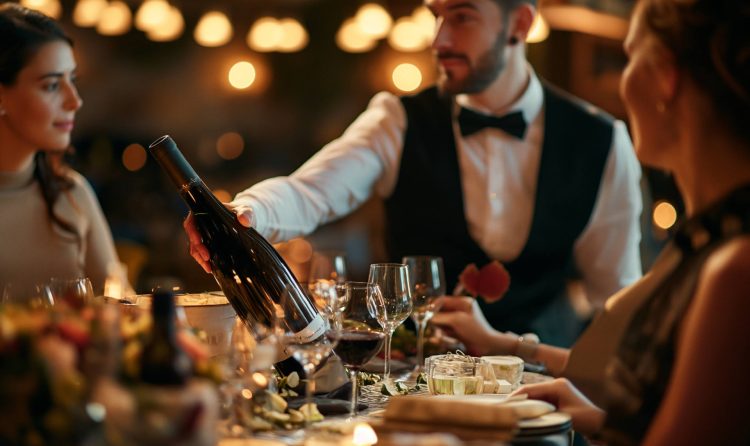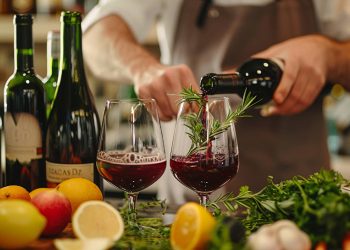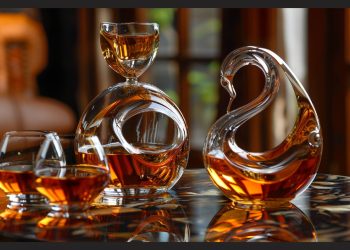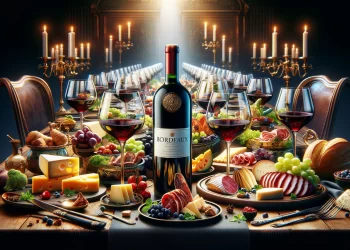In the fine dining world, presenting the wine presentation rituals has become a long-standing tradition. But have you ever wondered why this customary gesture is still practiced in the modern restaurant industry? What purpose does it serve? As we explore the reasons why waiters show the wine bottle, we will uncover the hidden significance and practicality of this seemingly simple act. From confirming the correct wine selection to ensuring a smooth billing process, the presentation of the wine bottle holds secrets that are sure to captivate your curiosity.
So, let us embark on a journey through the world of wine service and discover the intricate details that make this ritual so essential in the fine dining experience.
The Significance of Wine Bottle Presentation
The significance of wine presentation rituals lies in its historical context and cultural importance. Wine bottle presentation has its roots in high-end fine wine culture, where it was customary for the nobility and elite to be familiar with wine taste. It has since evolved into a standard practice in the restaurant industry, demonstrating professionalism, attention to detail, and expertise in wine service.
Historical Context of Wine Presentation Rituals
Throughout the centuries, the presentation of wine bottles has played a crucial role in the historical context of wine-serving rituals, serving as a symbolic gesture of elegance and sophistication. Wine pouring and bottle presentation have been part of wine rituals, reflecting the importance of wine in various cultures. The act of presenting the wine bottle to the customer signifies a level of respect and attention to detail, showcasing the server’s knowledge and professionalism.
This tradition has its roots in high-end fine wine culture, where the nobility and elite were familiar with the taste of wine. Over time, the practice of wine bottle presentation has evolved and become customary across all price levels of wine, further cementing its significance in the wine culture. The wine bottle presentation ritual adds to the overall dining experience and ensures customer satisfaction and authenticity in the wine they are about to enjoy.
The Role of the Waiter and Sommelier
The role of the waiter and sommelier in wine presentation rituals is crucial to the overall dining experience. They are responsible for confirming the correct wine selection, ensuring customer satisfaction, and demonstrating professionalism. With their expertise and knowledge, they enhance the enjoyment of the wine and contribute to a memorable dining experience for the guests.
Responsibilities and Expertise
With their extensive knowledge and expertise in wines, the waiter and sommelier play a crucial role in ensuring a seamless wine tasting experience for patrons. Their responsibilities include wine service, wine expertise, wine selection, and wine knowledge, all of which contribute to customer satisfaction. The waiter and sommelier are trained to assist patrons in choosing the right wine to complement their meal, taking into consideration their preferences and budget. They are well-versed in the different types of wines, regions, and vintages, allowing them to provide valuable recommendations.
Additionally, their expertise extends to proper wine storage and handling, ensuring that the wine is served at the correct temperature and in the appropriate glassware. By fulfilling their responsibilities with professionalism and expertise, the waiter and sommelier enhance the overall dining experience and create a sense of belonging for customers who appreciate fine wines.
Enhancing the Dining Experience
As experts in the field of wines, waiters and sommeliers play a pivotal role in elevating the overall dining experience for patrons through their exceptional knowledge and service. They enhance the dining experience by:
- Wine Pairing: Waiters and sommeliers have the expertise to recommend the perfect wine that complements the flavors of the food, enhancing the taste and enjoyment of the meal.
- Wine Appearance: They ensure that the wine is presented in an appealing manner, taking into account the glassware, temperature, and serving technique, creating a visually pleasing experience for the patrons.
- Wine Pour: The skillful pouring of wine by waiters and sommeliers adds a touch of elegance and professionalism to the restaurant experience, making the patrons feel valued and attended to.
Wine Tasting Rituals in Restaurants
When it comes to wine-tasting rituals in restaurants, there is an art to tasting wine and involving the customer in the selection process. This process ensures that the correct bottle of wine is served, allows the customer to assess the quality and characteristics of the wine, and enhances the overall dining experience. The server or sommelier holds the wine in front of the customer, who examines its appearance, aroma, and taste, and may consult with the server for further discussion or recommendations.
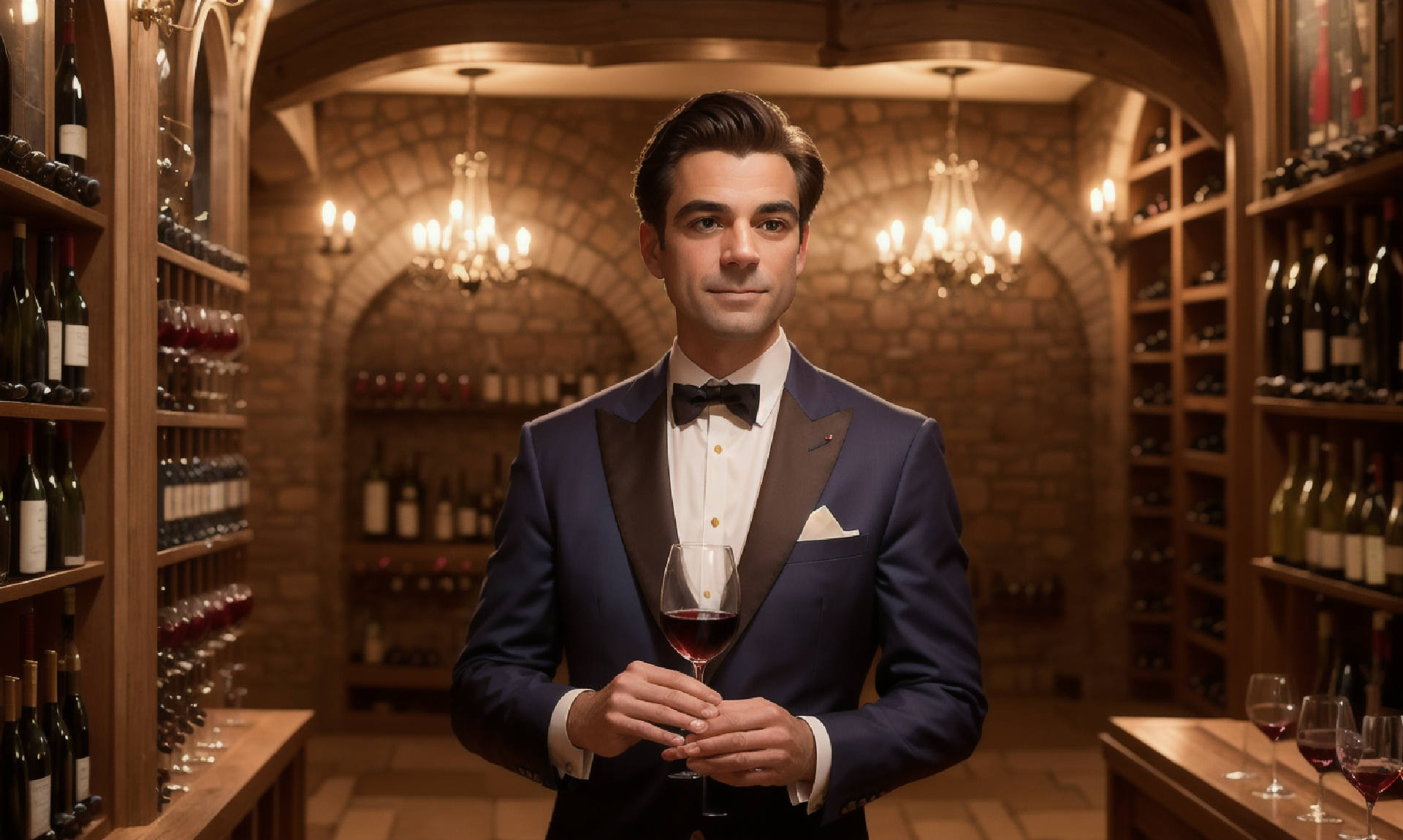
The Art of Tasting Wine
The wine-tasting rituals in restaurants encompass a refined and meticulous process that allows patrons to fully appreciate and evaluate the characteristics of the wine they have ordered. This art of tasting wine involves several important steps that contribute to the overall experience:
- Tasting the wine under the guidance of a sommelier or server
- Examining the color, aroma, and taste of the wine
- Describing the wine’s characteristics and flavor profile
- Consulting with the sommelier or server for further discussion or recommendations
- Appreciating the role of aromas in wine appreciation
- Understanding the importance of the taste test to assess the quality of the wine
Customer Involvement in the Wine Selection
Customer involvement in wine selection is an integral part of the wine-tasting rituals in restaurants, allowing patrons to actively participate in the process of choosing and experiencing their desired wine. This involvement empowers customers and enhances their wine experience by giving them a sense of ownership and control. It enables them to explore different options, consider their preferences, and engage in conversations with sommeliers or servers for advice and recommendations.
By following proper wine etiquette, customers can ensure that they select a wine of high quality that aligns with their tastes and preferences. This level of customer involvement adds to the overall dining experience and fosters a sense of belonging, as customers feel valued and respected in their choices.
Wine Pouring Etiquette
When it comes to wine-pouring etiquette, there are important techniques and traditions to follow in order to prevent spills and waste. Properly pouring wine requires skill and precision to ensure that each glass is filled to the appropriate level without overpouring. Additionally, understanding the proper order in which to pour for guests at the table demonstrates a level of professionalism and attentiveness.
Techniques and Traditions
With a rich history rooted in high-end fine wine culture, wine-pouring etiquette in restaurants encompasses various techniques and traditions. These practices contribute to the overall gourmet experience and fine dining atmosphere, ensuring a memorable meal pairing and upholding dining traditions. Here are some key techniques and traditions that make up wine-pouring etiquette:
- Proper presentation: Waiters show the wine bottle to the person who ordered it, confirming the correct selection and maintaining excitement for the wine.
- Label matching: This step helps protect against counterfeiting by verifying that the tasted wine matches the label, ensuring authenticity and quality.
- Professionalism: Following established wine presentation traditions reflects attention to detail and service quality, enhancing the overall dining experience and demonstrating the server’s knowledge and expertise.
These techniques and traditions are deeply rooted in dining etiquette, creating a sense of belonging and elevating the gourmet experience in fine dining establishments.
Preventing Spills and Waste
To ensure a smooth and efficient wine-pouring experience, proper technique and attention to detail are essential in preventing spills and minimizing waste. Wine pouring etiquette plays a crucial role in maintaining wine quality assurance and ensuring customer satisfaction. By following the appropriate procedures, servers can minimize the risk of spills and waste, enhancing the overall dining experience.
One effective way to prevent spills is by utilizing the correct pouring technique. By holding the bottle at a slight angle and pouring slowly, servers can control the flow of wine and avoid overfilling the glass. Additionally, using a napkin or small towel to catch any drips can further minimize spills and keep the table clean.
Another important aspect of preventing waste is proper bottle handling. By storing and serving wine bottles in a vertical position, sediment can settle at the bottom, reducing the chances of it being poured into a glass. This attention to detail ensures that only clear and flavorful wine is served to customers, avoiding any unpleasant experiences.
Incorporating these practices into wine pouring prevents spills and waste and demonstrates professionalism and expertise. By paying attention to the small details, servers can create a positive and enjoyable wine experience for guests, fostering a sense of belonging and satisfaction.
| Technique | Benefit |
|---|---|
| Proper pouring technique | Minimizes spills |
| Utilizing a napkin | Prevents table mess |
| Vertical bottle storage | Reduces sediment in the glass |
Wine Selection and Pairing
When it comes to wine selection and pairing, one important aspect is matching the right wine with the right meals. This can be a complex task, as different wines’ flavors and characteristics can complement or clash with certain dishes. To help navigate this process, sommeliers provide recommendations based on their expertise and knowledge of wine and food pairing.
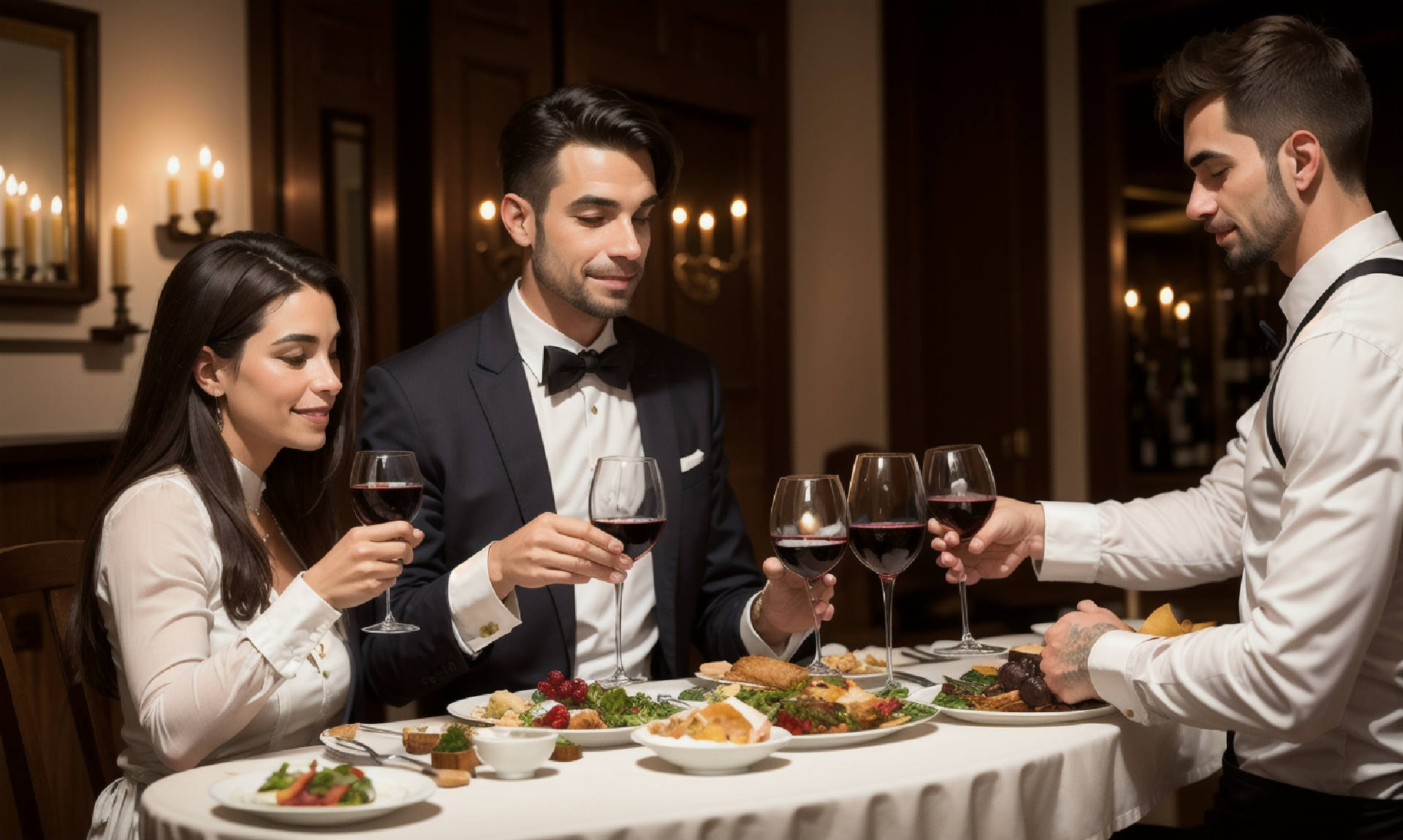
Matching Wine with Meals
Matching wine with meals is essential to creating a well-rounded dining experience. When it comes to pairing wine with food, there are several factors to consider. Here are three key points to grab your attention:
- Complementing Flavors: The right wine can enhance the flavors of your meal. For example, a rich, full-bodied red wine pairs well with a juicy steak, while a crisp white wine complements seafood or salads.
- Balancing Acidity: Wine with high acidity can cut through the richness of fatty or creamy dishes, providing a refreshing contrast. A zesty Sauvignon Blanc, for instance, can balance the creaminess of a pasta carbonara.
- Matching Intensity: The wine’s intensity should match the dish’s intensity. A bold, robust red wine is suitable for hearty, flavorful dishes like a lamb stew, while a light-bodied wine works well with delicate flavors like grilled fish.
The Sommelier’s Recommendations
After exploring the importance of matching wine with meals, we can now turn our attention to the sommelier’s expertise in wine selection and pairing. The role of a sommelier goes beyond simply presenting and pouring wine. They have extensive knowledge of different wine varietals, regions, and vintages, allowing them to make informed recommendations based on a customer’s preferences and the dishes being served.
Sommeliers consider factors such as acidity, body, and flavor profile when suggesting wines that will complement and enhance the flavors of a meal. Their recommendations can elevate the dining experience and create a harmonious balance between food and wine. By relying on the sommelier’s guidance, customers can feel confident in their wine choices and trust that they are making the most of their dining experience.
Understanding Wine Quality
Understanding wine quality is essential for wine enthusiasts and professionals alike. Assessing the aroma and appearance of a wine can provide valuable insights into its characteristics and potential enjoyment. Identifying wine defects such as cork taint or oxidation is crucial to ensure a high-quality wine experience.
Assessing Aroma and Appearance
When evaluating the quality of wine, one important aspect to consider is assessing the aroma and appearance. Here are some key points to keep in mind:
- Aroma: The scent of a wine can provide valuable information about its quality and characteristics. Take note of any pleasant or off-putting aromas, as they can indicate the wine’s freshness, fruitiness, or potential flaws.
- Appearance: The visual aspect of wine can also reveal important details. Look at the color and clarity of the wine, as well as the viscosity or “legs” that appear when the wine is swirled. These factors can give insights into the wine’s age, grape variety, and potential quality.
- Attention to detail: Assessing the aroma and appearance of wine demonstrates your knowledge and expertise, allowing you to appreciate and enjoy the wine fully. It also shows your commitment to the dining experience and the desire to provide a high standard of service.
Identifying Wine Defects
Assessing the aroma and appearance of wine is crucial in understanding its quality, and a natural progression from this evaluation is the ability to identify wine defects, allowing for a comprehensive understanding of wine quality. Identifying wine defects is an important skill for wine enthusiasts and professionals alike. Wine defects can occur due to various factors, such as faulty winemaking practices, improper storage conditions, or the presence of contaminants.
Common wine defects include cork taint, which imparts a musty or moldy aroma to the wine, oxidation, which leads to a flat or stale taste, and volatile acidity, which results in a vinegary smell. By being able to detect these defects, individuals can make informed decisions about the quality of the wine and ensure a more enjoyable wine-drinking experience.
The Cultural Importance of Wine Serving
The cultural importance of wine serving is deeply rooted in the history of fine dining and has evolved over time. Wine has long been associated with nobility and the elite, and the act of presenting the wine bottle to the customer signifies professionalism and attention to detail. The practice also serves as a means of protecting customers from counterfeiting and ensuring the authenticity and quality of the wine being served.
Wine in Fine Dining
Wine plays a pivotal role in the cultural experience of fine dining, with its serving process serving as a symbol of sophistication and refinement. It is an integral part of the dining ritual, creating an atmosphere of elegance and luxury. Here are three reasons why wine is essential in fine dining:
- Enhancing the dining experience:
- Wine complements the flavors of the food, elevating the overall taste.
- It stimulates conversation and creates a convivial atmosphere.
- Pairing wine with each course enhances the sensory journey of the meal.
- Signifying status and knowledge:
- Selecting and appreciating fine wines demonstrates one’s sophistication.
- Knowing about different wine regions and vintages conveys expertise.
- Wine connoisseurship is a mark of belonging to a cultured and refined community.
- Preserving tradition and heritage:
- Wine has been an integral part of fine dining for centuries.
- It connects us to the rich history and cultural traditions surrounding wine production.
- The rituals of wine service showcase the continuity of these traditions.
The Evolution of Wine Serving Traditions
Over the centuries, the act of presenting and serving wine has evolved into a cultural tradition that holds great significance in the dining experience. Wine presentation rituals have become an integral part of the restaurant industry, reflecting the attention to detail and service quality expected by customers. The presentation of the wine bottle not only confirms the correct selection but also helps to avoid potential billing issues and maintain excitement for the wine. It demonstrates the professionalism of the server and ensures customer satisfaction.
This practice originated from high-end fine wine culture, where the nobility and elite were familiar with the taste of wine. It has since continued to evolve and is now applicable to all price levels of wine, making it a customary and proper tradition that enhances the overall dining experience.
Wine Presentation Rituals: The Art of Wine Presentation
Exhibiting finesse and sophistication, the art of wine presentation rituals in restaurants showcases meticulous attention to detail and commitment to customer satisfaction. This age-old tradition not only adds an element of elegance to the dining experience but also serves several practical purposes. Here are three key takeaways:
- Enhancing the dining experience:
- The presentation of the wine bottle adds a touch of theater and excitement to the table, creating a sense of anticipation and celebration.
- It sets the stage for a memorable dining experience, making the customer feel valued and special.
- By upholding the traditions of wine presentation, restaurants demonstrate their commitment to providing a high-quality and refined dining experience.
- Ensuring authenticity and quality:
- Presenting the wine bottle allows customers to verify that the wine they ordered matches the label, protecting them from counterfeit or inferior wine.
- Inspecting the bottle, vintage, and cork provides an opportunity to assess the wine’s condition and ensure its quality.
- This practice safeguards customers from fraudulent practices and reinforces the restaurant’s reputation for serving genuine and high-quality wines.
- Demonstrating professionalism and expertise:
- The art of wine presentation showcases the server’s knowledge, expertise, and attention to detail.
- It reflects the restaurant’s commitment to professionalism and elevates the overall dining experience.
- By adhering to established wine presentation traditions, restaurants establish themselves as trusted authorities in the world of wine.
As a last word, the presentation of the wine bottle by waiters is a significant practice in the restaurant industry. It confirms the wine selection, prevents billing issues, and maintains excitement for the wine. Additionally, it showcases the professionalism and expertise of the server. Through label matching and protection against counterfeiting, this gesture ensures customer satisfaction and enhances the overall dining experience. The art of wine presentation is a crucial aspect of fine dining, symbolizing wine’s cultural importance and appreciation.

